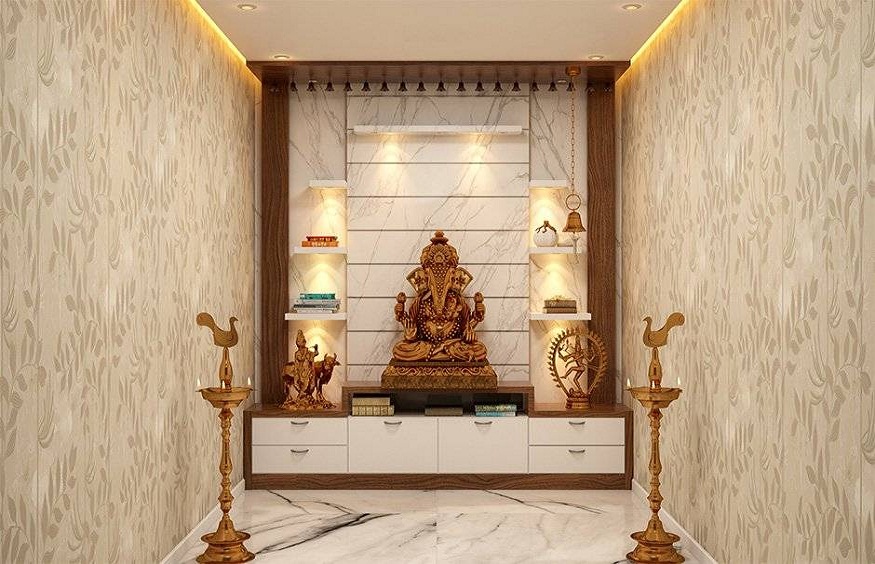The Pooja room is a sacred space in many homes. It’s where prayers are offered, meditations take place, and a deep connection to the divine is fostered. Choosing the right color for this spiritual sanctuary is key to creating an atmosphere of tranquility and reverence. Among all the hues, the color white remains one of the most popular choices for Pooja room designs—and for good reason.
The Symbolic Significance of White
White holds deep spiritual and religious importance across cultures and traditions. It is universally associated with purity, peace, and positivity—qualities that align perfectly with the purpose of a Pooja room.
- Purity: Pooja rooms are spaces intended for spiritual growth and devotion. The color white symbolizes cleanliness and an untainted state of being, making it an ideal backdrop for conducting rituals and prayers. It creates an environment that feels pure and unblemished, perfectly suited for divine worship.
- Peace: White is a calming color. It naturally evokes a sense of peace, offering a soothing ambiance to pooja mandir designs. This sense of calm is crucial in creating the spiritual alignment necessary for worship.
- Positivity: By reflecting light, white eliminates dark corners and shadows, filling the space with brightness. This makes the room feel open and inviting, reinforcing feelings of hope and positivity.
Get an estimate for your home interior design project using the Beautiful Homes interior cost calculator!
Aesthetic Appeal of White in Pooja Rooms
Apart from its symbolic meaning, white is a favorite for Pooja room designs due to its timeless aesthetic.
- Serene Atmosphere: The color white brings a sense of tranquility, making the Pooja room feel serene and sacred. It harmonizes perfectly with the purpose of the space, ensuring an uninterrupted focus on prayer.
- Bright and Airy Vibes: Small or poorly lit spaces can sometimes feel cramped. White has the magical ability to reflect natural and artificial light, making even the tiniest pooja mandir designs appear larger and brighter. This light, open vibe enhances your emotional experience in the room.
- Complementary Backdrop: White also acts as the perfect neutral background for decorative elements in your pooja mandir designs. Intricate brass lamps, vibrant idols, colorful floral garlands, and any other religious accessories look stunning against a white backdrop, creating a visually cohesive and beautiful space.
Benefits of White
Beyond looks, white offers several practical advantages that make it a smart choice for Pooja rooms:
- Easy to Coordinate: Whether you’re using marble flooring, custom carpentry, or simple paint, white coordinates seamlessly with any material or design style. It works well in traditional, modern, or minimalist styles.
- Clean and Clutter-Free: White emphasizes cleanliness—an essential quality for a sacred space. Any dust or dirt becomes more visible, encouraging regular maintenance and keeping the room looking pristine and divine.
- Timeless Color: While trends in interior design come and go, white remains a classic choice. You won’t need to redecorate or repaint frequently, as white never goes out of style.
Tips for Incorporating White in Pooja Room Designs
If you’re ready to bring the calming beauty of white into your Pooja room interior design, here are a few ideas and tips to make it work well for your home:
- White Marble: Opting for white marble for the flooring, walls, or even the altar gives the room an opulent yet minimalist look. Marble’s natural sheen enhances the brightness of the room and adds a touch of elegance.
- Paint It White: A simple coat of white paint on walls and ceilings instantly makes the room look airy and pure. You can further accentuate this with textures or patterns in white paint for added depth.
- Decorative Elements: Use white lamps, vases, or frames to tie the look together. White curtains or sheer blinds on windows can enhance the soft, divine lighting in the room.
- Textured Accents: If solid white feels too plain, introduce subtle textures with white panels, tiles, or moldings. Geometric patterns or floral motifs in white can add charm without overpowering the space.
Choosing white for your Pooja room design is more than just a stylistic choice; it’s a way to align the aesthetics of the space with its spiritual purpose. White embodies purity, peace, and positivity, creating an atmosphere conducive to worship and meditation. Its visual versatility ensures a timeless appeal while making the room feel brighter and more spacious. By incorporating white through materials like marble, paint, and thoughtful decor, you can craft a Pooja room that feels divine, serene, and truly special.
Get an estimate for your home interior design project using the Beautiful Homes interior cost calculator!

